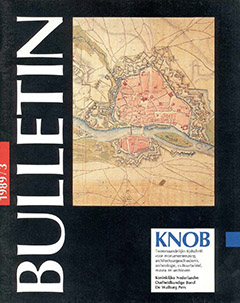Indexering ESCI / Scopus


F.W. van Voorden: Historische structuuranalyse Maastricht. Th.M. Elsing: Cultureel Erfgoed en Ontwikkelingssamenwerking. Titus A.S.M. Panhuysen: Het bodemarchief van Maastricht. Ed Taverne: Het stedebouwkundig monument. Serve Minis: In de ban van de stad. A.M. Martin: De ruimtelijke transformaties van Maastricht na 1800. Claes Joris van Haaften: Het Maastrichtse bouwarchief in relatie tot de stadsvernieuwing.
Maastricht probably is the oldest city of the Netherlands and the past is to be seen and to be felt in every street and alley, in the gables and in the ground. At some places the human activities of generations is reflected below the street-level of the city. Every generation adds archeological materials and destroys the elder artifacts. This since the Roman era, 200 A.D.
Recently the archeology is also considered of great importance for the knowledge and science of the development of the city. During the 19th century and the first half of the 20th century incidental excavations...
The Dutch city planning hardly has any relations with the historical and architectural structure of the city. Historical and architectural structures were ignored by the architects of the New Building and even by the more traditional architects of the Delft School. Also no coherent theories of building and city-planning were developed with the historical urban structure as background.
The defensive attitude of the Preservation of Monuments did not result in changing opinions or in improvements of city-planning and design. Recently the historical analysis of the city became more...
The present border of the municipality Maastricht has largely been determined by the Peace treaty concluded at London in 1839 between Holland and Belgium. The fortified city of Maastricht stayed Dutch possession after the Belgian Revolt (1830). At the Peace Treaty of 1839 Limburg was divided in two. The new state frontier followed the river the Maas. Only at Maastricht the borderline was drawn about 2,5 km's to the west respecting the surroundings of the fortification.
From medieval times on the sovereign was entitled to remove all obstacles within this zone at threatening war....
The architectural history of a city consists in a returning exchange of influences between the city itself and its architecture. Up to the 19th century a gradual internal development determinated the character of the city and returning processes of changing leave their traces. The identity of the city is a source of knowledge concerning the past and the future of the city.
Since 1800 cities have a larger need for control on the urban development, Maastricht has always been an important merchant- and fortified city. It is a unique city because of the fact that from 1350 the internal...
In 1988 the previous White Women-cloister at the northern side of the Vrijthof has had to make way for the planned 'Musictheatre' at Maastricht. Historical research dated parts of the three demolished cloister wings as built ca. 1515. Some cellars were older. An important conclusion from the results of the research is, that behind 17th century facades parts of in Maastricht very rare late medieval buildings were hidden.
Stock-taking of monuments shows that churches, cloisters and city-walls excluded, in Maastricht almost nothing is left from the period 1000-1600. Research however...


open access mogelijk gemaakt door Stichting OpenAccess
